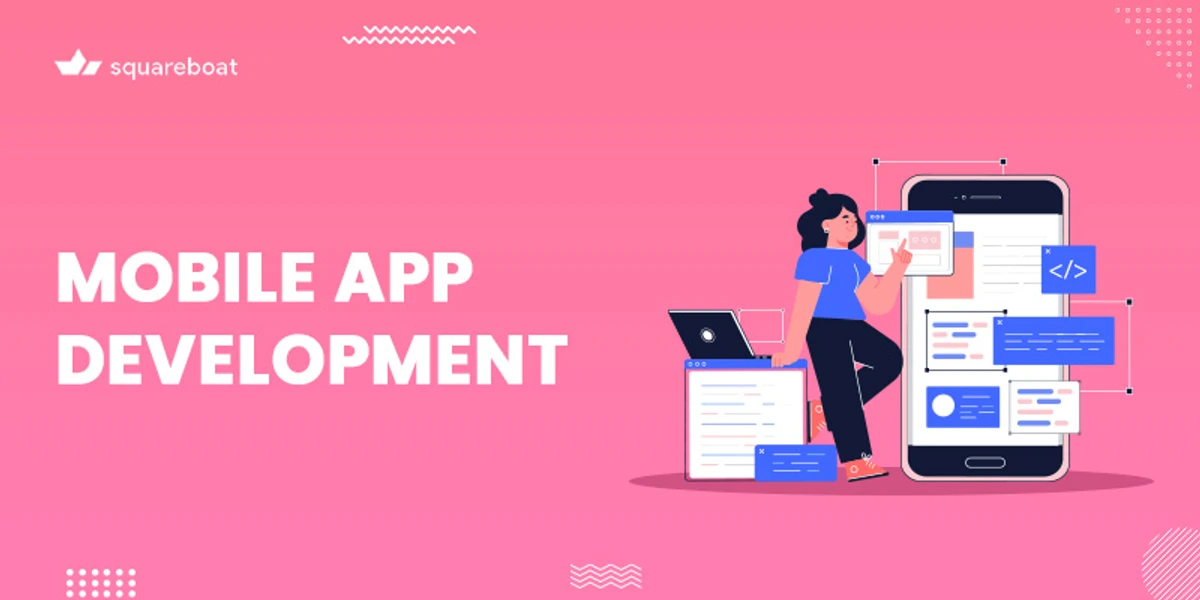Mobile Apps have become an integral aspect of life today. There are apps available for almost every purpose, like entertainment, calculations, gaming, education, E-commerce, etc. According to Statista, over 2.8 million apps are currently available on the Google Play Store and over 2.2 million on the Apple App Store. Undoubtedly, this number will continue to grow in the coming years. Therefore, mobile app development has become a widely recognized skill today.
If you are willing to develop a mobile app development skill and want to know its nitty-gritty, this article is for you. The article helps you understand mobile app development, its types, and the entire development process.
So, let us begin!
What is Mobile App Development?
It is a process of developing applications or software programs for smartphones and tablets, especially for Android and iOS operating systems. We also refer to it as “Mobile Application Development”. Typical examples of mobile apps include WhatsApp, Amazon, Spotify, Flipkart, etc.
Android and iOS are two popular platforms, with a market share of 68.79% and 30.44%, respectively. Hence, companies develop applications targeting these platforms. Many businesses today also outsource mobile application development to expert teams to save time, reduce costs, and ensure high-quality app performance.
iOS is a platform from Apple Inc. that powers all lines of Apple devices. On the other hand, Android is a platform from Google that powers a wide range of devices, including those manufactured by Google. Developers have to leverage different software development kits (SDKs) and development toolchains to create apps for iOS and Android.
Mobile app development is analogous to web app development, which follows the traditional software development approach. However, the only difference is mobile apps are built to leverage a mobile device’s features. For instance, a gaming app can leverage an iPhone’s accelerometer.
The programming languages used to develop mobile apps include Java, Swift, Kotlin, Objective-C, etc. One commonly asked question by beginners is: “If we develop apps on computers, how do we test them on mobiles”. Well, this is where “emulators” come in. They can run the apps on your computer as a virtual mobile device. Popular emulators include Android Emulator, Genymotion, iOS Simulator, etc.
Why is Mobile App Development Important?
Mobile app development is a significant part of the current digital world because mobile devices have become fundamental to everyone. These apps make it convenient for users to access the information at their fingertips rather than visiting websites for every small task.
You can find mobile apps for every purpose, whether social networking, phone calls, gaming, or entertainment. Various businesses, from retail and telecommunications to healthcare and insurance, offer mobile apps to their customers, allowing them to manage transactions and access information easily and quickly.
Many companies, like Uber, Instagram, Airbnb, etc., have shifted to mobile apps as their primary platform. These apps make it effortless for companies to stay connected with their customers and be responsive to their queries and issues. Besides, they are more secure than web apps since the Internet is more vulnerable to attacks.
Types of Mobile App Development
The following are the four different approaches for mobile app development:
1. Native App Development
It involves creating applications specific to an operating system. Native apps operate only on the platform or device they are intended to use. For instance, an app native to Android works only on Android devices and not on devices running on other platforms. In addition, native apps are developed using platform-specific programming languages and frameworks.
Pros
- Exceptionally high runtime performance.
Direct access to a device’s API.
Cons
- Extremely expensive to develop and maintain native apps.
Requires a separate codebase for each platform.
2. Cross-Platform App Development
It is the process of developing applications that work on multiple mobile operating systems. Cross-platform apps are platform-agnostic, i.e., they run on any device regardless of OS. They are developed using a variety of programming languages and frameworks. However, they are compiled into native applications to run seamlessly on a device's operating system.
Pros
- A single codebase to develop an app for multiple platforms.
Cross-platform apps are easy to develop and maintain.
Cons
Cross-platform apps do not provide high performance compared to native apps.
3. Progressive Web App Development
It simply includes creating websites that users can access through a web browser over the Internet from any device. These websites appear and operate as if they are mobile apps. Unlike native mobile apps that you download and install, you can use progressive web apps through your web browser without requiring them to download and install.
Pros
- No installation is required; it can be accessed through a URL.
- No manual updates are required.
Independent of app stores.
Cons
- Limited support for native device features.
Complex development.
4. Hybrid App Development
It combines the features of both native apps and web apps. The development of hybrid apps requires the use of web technologies – HTML/CSS and JavaScript. Further, you must bundle these apps as app installation packages to allow users to install and run them on mobile devices, just like native applications.
Pros
- A single codebase for web and mobile apps.
- Requires web development skills to develop mobile apps.
Lower costs.
Cons
- Not ideal for high-performance apps.
- High development complexity.
Limited access to native device features.
Popular Mobile App Development Frameworks
Here is the list of some popular mobile app development frameworks along with their primary uses:
- React Native: Create native apps using JavaScript and React.
- Flutter: Developed by Google, Flutter enables the development of high-performance, cross-platform apps with a single codebase.
- Cordova: Build cross-platform apps using web technologies, and get access to native device APIs through plugins.
- Xamarin: Develop cross-platform apps using C# and .NET.
Ionic: Build hybrid mobile apps using web technologies such as HTML, CSS, and JavaScript.
Which Framework Should You Use?
Choosing a suitable framework depends on the following factors:
- Target Platform: Frameworks like React Native and Xamarin support both iOS and Android development. On the other hand, frameworks like Ionic are ideal for building cross-platform apps using web technologies.
- Projects Requirements: Plan on the resources, complexity, animations, etc., you need for the app and then go ahead with the framework that best meets the requirements.
- Community Support: Look for the number of threads and discussions available on developer platforms like Github, Stackoverflow, etc., and the number of active users.
Documentation: Check how well the documentation explains the concepts. Make sure the sample codes and examples are also available in the documentation.
Mobile App Development Process
Here are the widely adopted steps for developing a fully-functional mobile app:
1. Define the Idea and Goals
Start with brainstorming your ideas. Find out problems people face in their daily lives and try to come up with digital solutions that can resolve those issues. Here are some starter questions you must ask yourself:
- What do you want your app to accomplish?
- What are the goals and objectives of your app?
- What problems will it solve?
- What features will it include?
- How much amount of money are you willing to invest?
- How will you develop the app?
Once you decide what features your app will have, stick to them and avoid any kind of add-ons that deviate from your primary goal.
2. Market Research
After you define your goals and app features, it is time to research competitors. Look at similar applications that are already in the market.
Find answers to the following questions:
- Who are the potential competitors and target audience?
- What strategy will differentiate you from others and make you stand out from the crowd?
- On which platform will you launch your app?
- What strategy will you use to promote your app?
This step is crucial and unavoidable. If your idea has no market value, market research helps you save money, time, and effort before you start implementing the idea.
3. Create Wireframes and Prototypes
A wireframe is a rough sketch or blueprint for your application. It helps you visualize your app’s appearance before development. On the other hand, a prototype is an early model of an app developed to test its functionality.
Creating wireframes and prototypes helps refine your app’s appearance and functionality before the actual development and saves a lot of money.
4. Implement the App Code
Once you finalize a prototype, choose the programming language, framework, development approach, and team. After that, start implementing the code to bring your app to life.
The implementation process varies depending on the type of app you will develop. If you decide to create a native app, your team will have to create separate versions of the application for different platforms. If you opt for cross-platform development, a single codebase is enough to create an application for multiple platforms.
Additionally, the budget and the timeline depend on the same, in addition to the complexity of features. A basic app with a few features is affordable and quick to build. However, complex apps require more budget and time.
5. Test and Debug the App
Testing is inevitable in any development process. It ensures that your app is free from bugs and errors and meets all the requirements specified at the onset of development. It is essential to put your app through multiple checks, such as functional and performance checks.
After validating the app for functionality and correctness, release it to real users.
6. Maintain and Update the App Regularly
Once your app is live, monitor its performance regularly, track user feedback, and address any issues. Update your app with bug fixes, security patches, and new features.
Conclusion
This was all about mobile app development. It is the process of developing apps that run on mobile devices and tablets using programming languages and frameworks. With the increasing use of mobile devices, companies must provide mobile apps to remain competitive and engage their customers. Moreover, mobile apps create a better-personalized space for users.
Several frameworks are available for mobile app development, including Flutter, React Native, etc. Choosing a framework depends on the use cases and requirements, community support, and documentation.
Proper practices and good research make it easy to create scalable mobile apps.
People are Also Reading:


